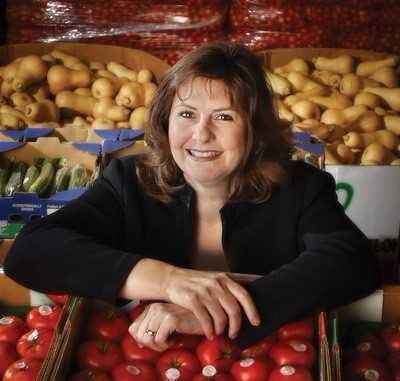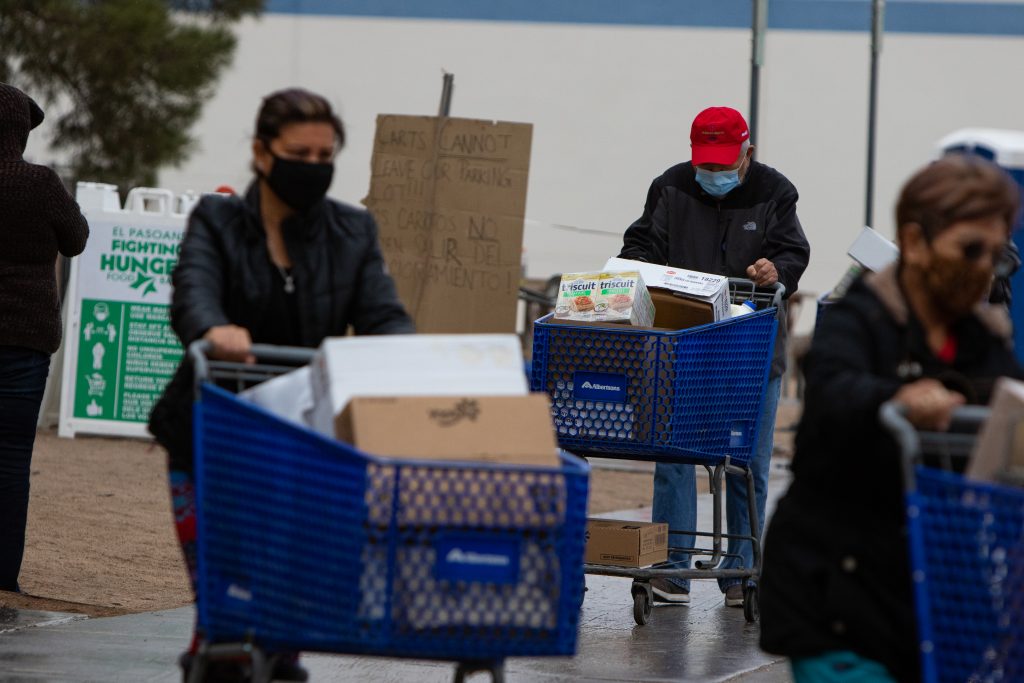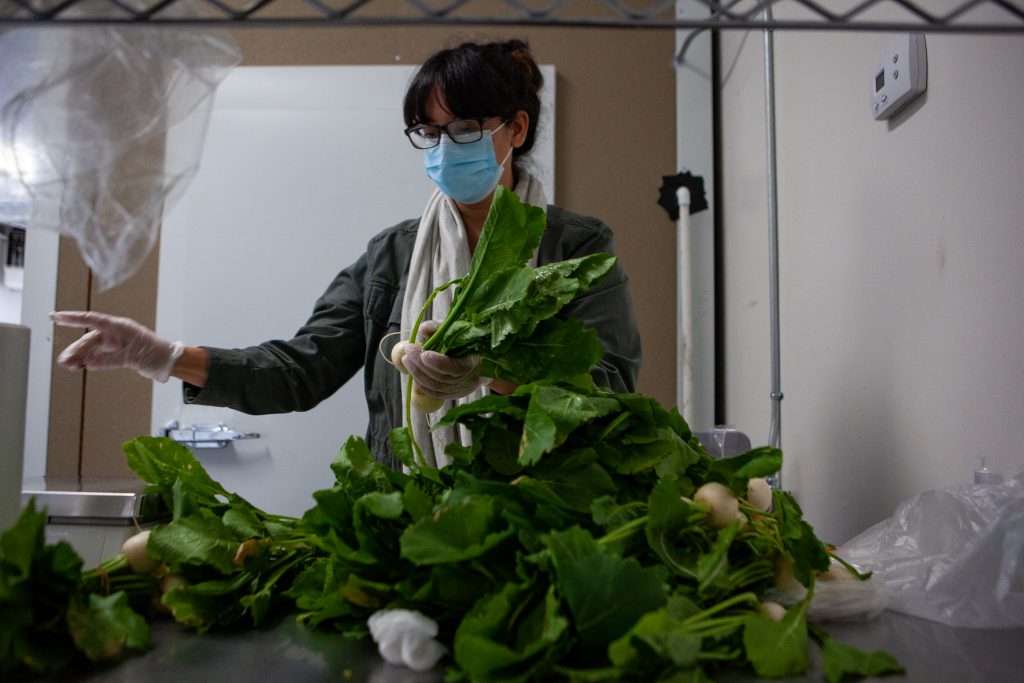El Paso’s Food Insecurity Challenges May Grow in Coming Months

Lorena Montoya, like thousands of El Pasoans facing financial hardships during the COVID-19 pandemic, has been relying on the El Pasoans Fighting Hunger Food Bank to help feed her family.
Montoya, who cleans houses for a living, said it has been difficult to find work since March. She lives with her 21-year-old son Stephen Montoya and her 14-year-old son Justin Montoya while her husband Juan Montoya works out of town doing construction.
Without the aid from the food bank, Montoya said they would be struggling.
“When the pandemic started in March, someone from church told me they were giving out food and that’s when I started to go,” Montoya said. “I haven’t struggled with food. I have had food for my family and to share with other people because the food they give us is excellent, but the truth is a lot of families would have struggled (without it).”

Lorena Montoya prepares to separate the food items she received into boxes that she will share with three other households. Montoya, who lost her income for several months when she contracted COVID-19 and had to stop cleaning houses, was just recently able to start working again. (Corrie Boudreaux/El Paso Matters)
Montoya’s situation is not unique. COVID-19 has caused economic devastation, overwhelmed the health-care system and exacerbated food insecurity in El Paso — an issue that has long been a silent battle for families who do not know where their next meal may be coming from.
Local organizations and programs have been working toward addressing food insecurity in the region in the long term, but the pandemic has created an urgent need to ensure families like Montoya’s do not go hungry.
Immediate need
The El Pasoans Fighting Hunger Food Bank has had to adapt to the overwhelming need to provide food for thousands of struggling families. Officials are concerned that with emergency funding sources dwindling by the end of the year, it may be difficult to sustain the prolonged need the community continues to face.
“There is a lot of uncertainty that we’re facing come January and we are talking to everybody that will take a phone call from us and saying: please help,” said El Pasoans Fighting Hunger CEO Susan Goodell.

Susan Goodell
Prior to the pandemic, the food bank mainly served as a hub to receive and distribute food to its partner sites including food pantries, shelters and soup kitchens throughout the city. In March, there was an abrupt change to disaster response, which meant providing emergency food directly to families.
Six days a week from before the sun rises until after the sun sets, anywhere from 6,000 to 8,000 families drive through designated sites to pick up emergency food, including the food bank parking lot at 9541 Plaza Circle in the Lower Valley.
Goodell said the food bank has been distributing unprecedented amounts of food for about 138,000 households per day since the pandemic hit.
“My first year here we’ve provided 16 and a half million (pounds of food). In my second year it was 32 and a half million pounds — and this year we’re on pace to do about 130 million pounds,” Goodell said. “The largest food bank in the world (in Houston) provided 125 million pounds in 2019 and we’re going to provide 130 million this year.”
Other food banks around the country also are providing previously unimaginable food to combat hunger during the pandemic.
Navigating challenges
Goodell likens the obstacles the food bank has had to overcome to a game of Whac-A-Mole.
The organization had to scramble to find resources, including funding, manpower, food and space to prepare to distribute directly to families. Goodell said they added 100,000 square feet of warehouse space to be able to accommodate for social distancing requirements and other changes.
“All of these things are necessary to be able to feed 138,000 people a day,” Goodell said. “Early on we were cobbled together with volunteers and staff.”
She said the largest food bank in the world, which was Houston’s last year, had 600 employees, El Paso’s food bank has 60.
Goodell said they were able to get help for a few months from the National Guard, but they left in July. The food bank was also able to get help from volunteer organizations like Team Rubicon and AmeriCorps, but as those resources fluctuate and participation declines, the need for volunteers is constant, she said.
Goodell said there were also issues early on with the food supply. The food bank had completely run through its inventory of dry goods within two weeks.
“That was a pretty ugly position to be in at the end of March with no food in the facility. We were constantly scrambling to find food and to find sources of food that perhaps others hadn’t quite been driven through yet,” Goodell said.

People wheel their grocery carts with boxes of food to their vehicles to be unloaded at the El Pasoans Fighting Hunger food bank. (Corrie Boudreaux/El Paso Matters)
Goodell said a majority of goods being trucked throughout the country early in the pandemic were being redirected toward big box stores and grocery stores, leaving little access for food banks.
The organization shifted to seeking out more fresh foods, but others around the country made the same shift. Goodell said they then pivoted to seek out food that was being packaged for the restaurant industry or cafeterias that were no longer operating at full capacity.
Goodell said that sustained them through the summer months, but there were times where the food bank was down to one-and-a-half day’s supply of food for the city.
“It was pretty darn scary,” she said.
Goodell said federal and state funding has helped the food bank purchase food since September, but those funds will dry up by the end of December..
Goodell said the food bank has been very nimble and stretches its dollars and will continue to do so to bring food to feed families. But she urges the community to either donate time or money to help address the ongoing crisis.
“I think one way to think about it, at least from my perspective, is I think all of us feel that if our neighbor were hungry, we would do something to help them. I can tell you that our neighbors are hungry,” Goodell said.
Long-term solutions
While the El Pasoans Fighting Hunger Food Bank is addressing the immediate need for emergency food, the county government and researchers have been trying to find longer-term solutions to address the region’s food deserts and food insecurity.
Leah D. Whigham has been researching ways to help improve food systems in the region. She is an associate professor with the department of health promotion and behavioral sciences and director of the Center for Community Health Impact with the University of Texas Health Science Center at Houston and School of Public Health El Paso.

Leah Whigham
“The big picture problem is we need to think in terms of the whole food system,” Whigham said. “We have a food system that relies heavily on food from outside sources.”
She said some of the issues that surfaced during the pandemic crisis were food production and distribution channels — such as meat processing plants — that were forced to shut down due to COVID-19 outbreaks. Those closures impacted the national supply of meat and limited what was available at local grocery stores.
“This pandemic is a pretty extreme example, but in general, if we have a nimble food system and a stronger food system, then we can be much better at helping people from our communities that need improved access,” Whigham said.
Whigham, who worked on a report done in partnership with the Paso del Norte Institute for Healthy Living and The Food Trust, mapped areas in El Paso where access to grocery stores was disproportionately affecting low-income families, which contribute to food deserts.
“You can kind of see that we’ve got a corridor, most of our grocery stores are along I-10, so anyone that lives very far from that corridor have to drive quite a ways to get to a grocery store — so that’s part of it, but it’s also having the ability to buy the groceries.”
Improving access to healthy food
Gabriela Gallegos, associate professor with the department of management, policy and community health with the University of Texas Health Science Center at Houston and School of Public Health El Paso, has been working with Whigham and El Paso County to address access to healthy food in underserved areas.
In 2018 the county launched the El Paso County Healthy Food Financing Initiative, a public-private partnership that offers grants and loans to businesses and non-profit organizations to support and accelerate the construction, establishment, rehabilitation, and expansion of food retail and food retail structure that will increase healthy food options for current underserved residents in El Paso County.
“It’s a great strategy for long-term sustainability and resiliency, especially in these times,” said Valerie Valencia, heritage tourism coordinator with the El Paso County Economic Development department.
The first round of grants was awarded in March, just as the pandemic began accelerating.
The nonprofit Desert Spoon Food Hub was among the first three projects to be funded.
Desert Spoon aims to improve the local food system by helping small regional farmers sustain their livelihoods and making access to fresh fruits and vegetables attainable for families in underserved areas.
Adriana Clowe, president and one of four founders of Desert Spoon, said the nonprofit received $150,000 through the county program.
“A lot of the work that we do is ensuring that the community has access to food, but we also do a lot of work on the other side with producers to ensure they have a marketplace,” Clowe said.

Adriana Clowe, president of Desert Spoon, weighs produce as she prepares food boxes at her warehouse. Desert Spoon sources all of its produce from farmers in the El Paso region. (Corrie Boudreaux/El Paso Matters)
Before the pandemic, Desert Spoon was working with regional farmers to provide a way for them to sell their goods locally. Clowe said when the first stay-at-home orders were put in place in March, the demand for the food boxes skyrocketed.
Clowe said prior to receiving the county funding, the nonprofit relied on a warehouse in Las Cruces to prepare goods to be packaged in food boxes for delivery in El Paso. With the funding they received, they were able to build a warehouse in Central El Paso to expand operations and provide fresh food.
“The area that we’re in, the Rio Grande district, there used to be a VISTA Market there, and that closed last year in early January, so that area really has zero access in what they call a food desert, and it is a low income area of El Paso,” Clowe said. “It puts people at quite a bit of a challenge of making sure that they have access to healthy food.”
As part of their COVID-19 response, the nonprofit started the Food Project, which provides access to fresh fruits and vegetables to about 200 families residing in El Segundo Barrio, Central El Paso and Sunland Park, New Mexico. Desert Spoon worths through a referral program in partnership with Centro De Salud Familiar La Fe, Ciudad Nueva and La Clinica de Familia.
Clowe said part of the county funding will also allow Desert Spoon to open a storefront to serve the Rio Grande neighborhood area.
“It will give them more long-term sustainable access to healthy food and kind of incorporate that neighborhood into a dynamic value chain, where you have the food hub bringing fresh food in consistently and being able to provide it and make it accessible into that community pool,” Clowe said.
Access to benefits
Gallegos said several factors play a role in improving food insecurity. One of the most underutilized by families in El Paso is enrolling in the Supplemental Nutrition Assistance Program, or SNAP, which provides money for groceries.

Gabriela Gallegos
“It increases their buying power, which hopefully means that they can maybe supplement with food from a food pantry or a food bank, but then also be able to shift parts of their budget,” Gallegos said.
Gallegos said the SNAP program in El Paso has been underutilized, creating a “SNAP gap” between the number of families eligible to receive benefits and the number enrolled.
According to Texas Health and Human Services data on SNAP enrollments in November, almost 161,000 El Pasoans were eligible for SNAP benefits, but fewer than 71,000 were enrolled.
El Paso County is funding a survey that aims to understand the reasons people who might qualify for SNAP do not apply for the benefit.
Gallegos said the survey results will be used to develop a plan for capacity building and outreach about SNAP enrollment.
“There will always be people who qualify who aren’t accepting it, but if we can increase that and help more people have more money in their budget, specifically producers, that should give a little bit of respite to the emergency,” Gallegos said.
Learn more
To contact the El Pasoans Fighting Hunger Food Bank, call (915) 298-0353, or visit https://elpasoansfightinghunger.org.
To fill out the survey about SNAP enrollment, or for more information, call Gabriella Gallegos at (915) 975-8522, or fill out the survey at https://go.uth.edu/snap/ or call (915) 975-8523.
Cover photo: People waited in line despite the rain to receive food at the El Pasoans Fighting Hunger food bank last week. The food bank is distributing around 15 million pounds of food each month during the pandemic. (Corrie Boudreaux/El Paso Matters)
This article published in El Paso Matters on December 15, 2020.

